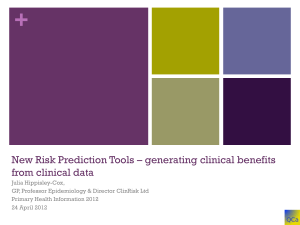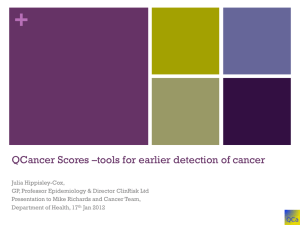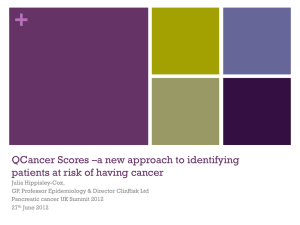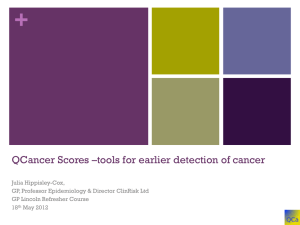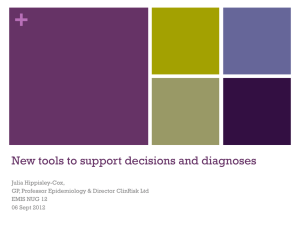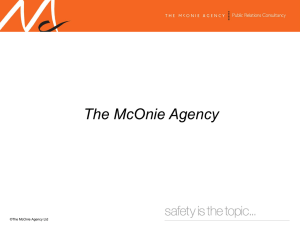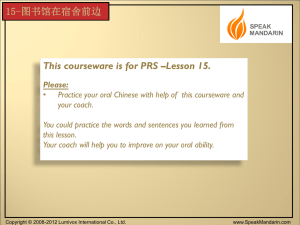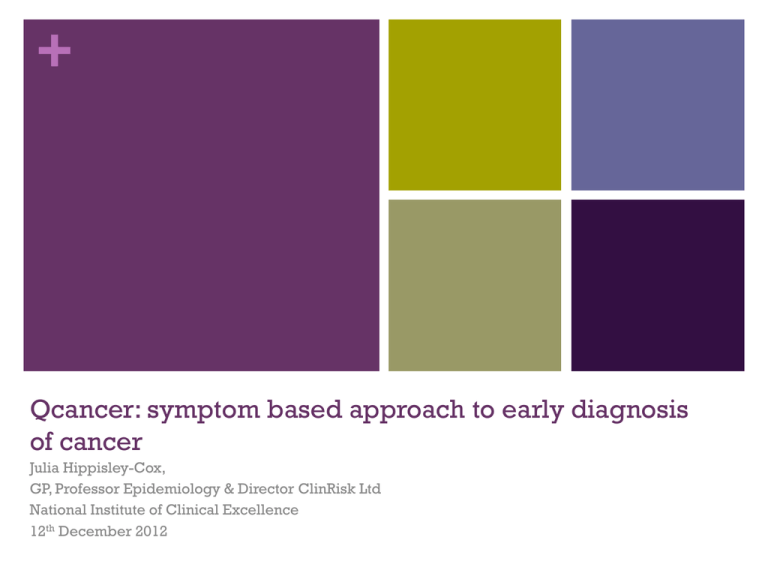
+
Qcancer: symptom based approach to early diagnosis
of cancer
Julia Hippisley-Cox,
GP, Professor Epidemiology & Director ClinRisk Ltd
National Institute of Clinical Excellence
12th December 2012
Acknowledgements
Co-authors
QResearch database
EMIS & contributing practices & User Group
University of Nottingham
ClinRisk (software)
Oxford University (independent validation)
Macmillan Cancer Support (funding implementation)
Copyright ClinRisk Ltd (2013) all rights reserved
Overview of talk on QCancer
QResearch database
Background on QScores
QCancer Model development
QCancer Model validation
QCancer Implementation
Pilot work with Macmillan and CRUK evaluation
Copyright ClinRisk Ltd (2013) all rights reserved
QResearch Database
www.qresearch.org
Over 700 general practices across the UK, 14 million patients
Not-for-profit venture between EMIS & Nottingham University
EMIS covers 56% of UK GP practices
Patient level pseudonymised database for research
Data linkage – deaths, deprivation, cancer, HES
Available for peer reviewed academic research where
outputs made publically available
Copyright ClinRisk Ltd (2013) all rights reserved
QScores –new family of Risk Prediction tools
Individual assessment
Population risk stratification
Identification of rank ordered list of patients for recall or reassurance
GP systems integration
Who is most at risk of current or preventable disease?
Who is likely to benefit from interventions?
What is the balance of risks and benefits for my patient?
Enable informed consent and shared decisions
Allow updates tool over time, audit of impact on services and
outcomes
Availability
All published, publically available as free open source or
professionally supported closed source software
Copyright ClinRisk Ltd (2013) all rights reserved
Qscores and national guidance
Risk score
Outcome
NICE guidance
Implementation
Qrisk.org
10 year risk of
CVD
Approved CG68 (2008)
QOF & DH vascular
screening program
All major GP
suppliers
Qdiabetes.org
10 year risk
diabetes
Approved PH38 (2012)
EMIS (largest
supplier > 55%)
Qfracture.org
10yr risk of
fracture
Approved CG146
(2012)
QOF 2013
EMIS 2013 +
London CCGs
Qthrombosis.org
Risk of VTE
Relevant to CG92
EMIS 2013
Qcancer.org
Current
cancer risk
Relevant to current
review
Pilot BMJ
informatica.
Later all suppliers
Copyright ClinRisk Ltd (2013) all rights reserved
Early diagnosis of cancer: The
problem
UK has relatively poor track record when compared with
other European countries
Partly due to late diagnosis with estimated 7,500+ lives lost
annually
Later diagnosis due to mixture of
late presentation by patient (alack awareness)
Late recognition by GP
Delays in secondary care
Copyright ClinRisk Ltd (2013) all rights reserved
Why symptoms based approach?
Many patients present with symptoms
GPs need to decide which patients to investigate and refer
Decision support tool must mirror setting where decisions made
Symptoms based approach needed (rather than cancer based)
Must account for multiple symptoms
Must have face clinical validity eg adjust for age, sex, smoking,
Family history
Need to be able to update to meet changing requirements,
populations, recorded data
Copyright ClinRisk Ltd (2013) all rights reserved
QCancer– what it needs to do
Accurately predict individual level of risk of multiple cancers
for based on multiple risk factors and multiple symptoms
Discriminate between patients with and without cancer
Help guide decision on who to investigate or refer and
degree of urgency.
Educational tool for sharing information with patient.
Sometimes will be reassurance.
Latest QCancer combined model published online BJGP 12
Dec 2012 and in paper version 01 Jan 2013
Copyright ClinRisk Ltd (2013) all rights reserved
Methods – development algorithm
Representative cohort from QResearch 2.5 million men &
women aged 25-89 years
cancer outcome - all new diagnoses on GP record or linked
deaths record in 2 years
Identify key symptoms
Identify key risk factors
Established methods to develop risk prediction algorithm
Measure of absolute risk of any cancer as well as by cancer
type
Copyright ClinRisk Ltd (2013) all rights reserved
Qcancer (2013) predicts global
cancer risk & risk12 types cancers
Lung
Pancreas
Renal tract
Ovary
•
Colorectal
Gastro
Testis
Cervix
•
Breast
Prostate
Copyright ClinRisk Ltd (2013) all rights reserved
Blood
Uterus
These
accounts for
85% cancers
Plan to
extend to
rarer cancers
when
sufficient data
Independent risk factors in model
Age & sex
Endometrial hyperplasia/polyp
Smoking status
Chronic pancreatitis
Deprivation score
Type 2 diabetes
Family history of cancer
Anaemia (HB < 11g/DL)
COPD
Venous thromboembolism
Copyright ClinRisk Ltd (2013) all rights reserved
Key symptoms in model
(identified from studies including NICE guidelines 2005)
Haemoptysis
Loss of appetite
Haematemesis
Unintentional weight loss
Haematuria
Indigestion +/- heart burn
Rectal bleeding
Dysphagia
Haematuria
Abdominal pain or swelling
Unexplained bruising
Breast lump, pain, skin
Constipation, cough
Night sweats
Vaginal bleeding (women)
Neck lump
Testicular lump (men)
Urinary symptoms (men)
Copyright ClinRisk Ltd (2013) all rights reserved
QCancer symptoms map women
blood breast cervix CRC
Abdo distension
Abdo pain
Anaemia
Appetite loss
Breast lump
Breast pain
Breast skin/nipple
changes
Bruising
Change in bowel
Constipation
Cough
Dysphagia
Haematemesis
Haematuria
Haemoptysis
Heartburn
Indigestion
IMB
Neck lump
Night sweats
PCB
PMB
+
+
+
+
+
+
+
+
OG
+
+
+
lung other ovary pancreas renal
+
+
+
+
+
+
+
+
+
+
+
+
+
+
+
+
+
+
+
+
+
+
+
+
+
+
+
+
1
10
5
8
n/a
+
+
+
+
+
+
+
+
+
+
+
+
+
+
+
+
Rectal bleed
VTE
+
Weight loss
Total
+
10
+
+
+
5
+
+
+
+
+
+
+
+
+
+
+
+
+
+
7
+
9
+
9
+
9
+
4
+
0
+
8
+
7
3
9
8
7
2
1
1
+
+
+
Total
1
4
2
1
4
3
6
1
1
6
2
3
1
1
7
+
+
+
+
+
+
+
+
+
uterine
QCancer symptoms map men
blood
CRC
gastro
lung
other
Abdo distension
+
+
Abdo pain
+
+
+
+
+
Anaemia
+
+
+
+
+
Appetite loss
+
+
+
+
+
+
+
Constipation
+
+
Cough
renal
testis
+
+
+
8
5
+
+
7
2
+
3
+
+
+
+
1
+
+
5
+
Haematemesis
+
Haematuria
+
Haemoptysis
+
+
Heartburn
1
+
+
+
3
+
+
4
+
3
+
1
Impotence
+
Indigestion
+
+
+
+
Neck lump
+
+
+
+
Night sweats
+
5
4
+
+
+
Retention
+
Testicular pain
VTE
+
Weight loss
+
+
Grand Total
13
8
1
+
Nocturia
Rectal bleed
total
3
Frequency
Testicular lump
prostate
+
Change in bowel
Dysphagia
pancreas
3
+
1
+
2
+
1
+
+
3
+
+
2
+
6
+
+
+
+
+
+
+
+
+
+
9
11
14
8
12
4
8
3
82
Methods - validation is crucial
Essential to demonstrate the tools work and identify right
people in an efficient manner
Tested performance
separate sample of QResearch practices
external dataset (Vision practices) at Oxford University
Measures of discrimination - identifying those who do and
don’t have cancer
Measures of calibration - closeness of predicted risk to
observed risk
Measure performance – positive predictive value, negative
predictive value, sensitivity, specificity at different thresholds
Copyright ClinRisk Ltd (2013) all rights reserved
Gold standard validation
Independent – not involving original study authors
External - test on cohort of patients not involved in original
derivation
Essential step to check model
Identifies right patients
Works in other settings – transportability
Different from evaluation
QCancer validation by Oxford University (Collins & Altman)
Collins GS, Altman DG. Identifying patients with undetected gastro-oesophageal cancer in primary
care: External validation of QCancer® (Gastro-Oesophageal). European journal of cancer 2012
Collins GS, Altman DG. Identifying women with undetected ovarian cancer: independent and external
validation of QCancer((R)) (Ovarian) prediction model. European journal of cancer care 2012 doi:
10.1111/ecc.12015.
Collins GS, Altman DG. Identifying patients with undetected colorectal cancer: an independent
validation of QCancer (Colorectal). Br J Cancer 2012
Copyright ClinRisk Ltd (2013) all rights reserved
Validation Results Women:
Discrimination ROC values
Combined
Individual
independent
symptoms model* cancer models in external validation
in separate
separate cohort
in Vision data
QResearch cohort from QResearch
any cancer
lung
colorectal
gastro
pancreas
ovary
renal
breast
blood
uterus
cervix
other
0.85
0.91
0.89
0.90
0.87
0.84
0.90
0.88
0.79
0.91
0.73
0.82
n/a
0.92
0.89
0.89
0.84
0.84
0.91
n/a
n/a
n/a
n/a
n/a
In progress
In press
0.92
0.93
In press
0.86
In press
In progress
In progress
In progress
In progress
In progress
*reference: Symptoms and risk factors to identify women with suspected cancer in primary care; BJGP; 2013
Copyright ClinRisk Ltd (2013) all rights reserved
Validation Results Men:
Discrimination ROC values
Combined
symptoms model*
in separate
QResearch cohort
any cancer
lung
colorectal
gastro
pancreas
renal
prostate
blood
testis
other
0.89
0.92
0.90
0.93
0.89
0.94
0.90
0.83
0.82
0.86
Individual cancer
independent
models in
external validation
separate cohort
in Vision data
from QResearch
n/a
0.92
0.91
0.92
0.87
0.95
n/a
n/a
n/a
n/a
In progress
In press
0.91
0.94
In press
In press
In progress
In progress
In progress
In progress
*reference: Symptoms and risk factors to identify men with suspected cancer in primary care; BJGP; 2013
Copyright ClinRisk Ltd (2013) all rights reserved
Validation women calibration
mean predicted & observed risk
lung
colorectal
female
0.0
0.0
0.5
0.5
% risk
% risk
1.0
1.0
1.5
1.5
female
0
5
10
0
5
Tenth of predicted risk
Observed risk
Predicted risk
Graphs by sex
Copyright ClinRisk Ltd (2013) all rights reserved
10
Tenth of predicted risk
Observed risk
Graphs by sex
Predicted risk
Validation women calibration
mean predicted & observed risk
gastro-oesophageal
pancreas
female
0.2
0.0
0.0
0.2
% risk
% risk
0.4
0.6
0.4
female
0
5
10
0
5
Tenth of predicted risk
Observed risk
Predicted risk
Graphs by sex
Copyright ClinRisk Ltd (2013) all rights reserved
10
Tenth of predicted risk
Observed risk
Graphs by sex
Predicted risk
Validation women calibration
mean predicted & observed risk
renal
blood
female
0.0
0.0
0.2
% risk
% risk
0.4
0.5
0.6
female
0
5
10
0
5
Tenth of predicted risk
Observed risk
Predicted risk
Graphs by sex
Copyright ClinRisk Ltd (2013) all rights reserved
10
Tenth of predicted risk
Observed risk
Graphs by sex
Predicted risk
Validation women calibration
mean predicted & observed risk
ovary
breast
female
0.0
0.0
0.2
% risk
% risk
0.4
5.0
0.6
female
0
5
10
0
5
Tenth of predicted risk
Observed risk
Predicted risk
Graphs by sex
Copyright ClinRisk Ltd (2013) all rights reserved
10
Tenth of predicted risk
Observed risk
Graphs by sex
Predicted risk
Validation women calibration
mean predicted & observed risk
cervix
uterus
female
0.1
0.0
0.0
0.2
% risk
% risk
0.4
0.6
0.2
female
10
5
0
Tenth of predicted risk
Tenth of predicted risk
Observed risk
Predicted risk
Graphs by sex
Copyright ClinRisk Ltd (2013) all rights reserved
10
5
0
Observed risk
Graphs by sex
Predicted risk
Comparison strategies in
women based on top 10% risk
Risk
threshold
%
Sensitivit Specificit
y (%)
y
(%)
PPV
(%)
NPV
(%)
lung cancer
0.38
72.1
90.1
1.2
99.9
colorectal
0.35
68.2
90.1
1.4
99.9
gastro-oesoph
0.14
75.0
90.1
0.6
100.0
pancreas
0.12
67.9
90.0
0.4
100.0
ovarian
0.18
61.6
90.0
0.6
100.0
renal
0.10
76.7
90.0
0.6
100.0
breast
0.72
68.1
90.4
4.6
99.8
blood
0.22
44.0
90.0
0.5
99.9
uterine
0.10
83.7
90.1
0.7
100.0
cervical
0.05
54.5
90.0
0.2
100.0
other
0.55
19.4
90.0
0.1
100.0
Copyright ClinRisk Ltd (2013) all rights reserved
Comparison strategies in men
based on top 10% cancer risk
% threshold Sensitivity specificity
(%)
(%)
PPV
(%)
NPV
(%)
lung
0.67
71.5
90.2
1.9
99.9
colorectal
0.45
69.5
90.2
1.8
99.9
gastro-oesoph
0.29
76.6
90.1
1.3
100.0
pancreas
0.10
70.1
90.0
0.4
100.0
renal tract
0.20
82.7
90.1
1.6
100.0
prostate
1.30
59.5
90.2
2.2
99.8
blood
0.27
49.0
90.1
0.6
99.9
testicular
0.02
67.1
90.0
0.2
100.0
other
0.66
27.0
90.0
0.1
100.0
Copyright ClinRisk Ltd (2013) all rights reserved
Web calculator www.qcancer.org
Publically available
Interactive
Gives global cancer risk
Risk of different cancer types
Visual display of absolute risk to help shared decision
making eg “of a 100 patients like 7you. 20 will have cancer”
http://www.qcancer.org/2013/male/
http://www.qcancer.org/2013/female/
Copyright ClinRisk Ltd (2013) all rights reserved
Using QCancer in practice – v similar
to QRISK2
Standalone tools
a.
Web calculator
www.qcancer.org/2013/female/php
www.qcancer.org/2013/male/php
b.
Windows desk top calculator
c.
Iphone – simple calculator
Integrated into clinical system
a.
Within consultation: GP with patients with symptoms
b.
Batch: Run in batch mode to risk stratify entire practice or
PCT population
Copyright ClinRisk Ltd (2013) all rights reserved
GP systems integration
Batch processing
Similar to QRISK2 which is in 95% of GP practices– automatic
daily calculation of risk for all patients in practice based on
existing data.
Identify patients with symptoms/adverse risk profile without
follow up/diagnosis
Enables systematic recall or further investigation
Systematic approach - prioritise by level of risk.
Safety netting
Copyright ClinRisk Ltd (2013) all rights reserved
Use QCancer website by single
cancer site (source: google 01 Nov 2012 to 10 Dec 2012)
Site
Journal
Publication
Date
Ovary
BMJ
Jan 2012
4,465
36%
Colorectal
BJGP
Jan 2012
2,799
77%
Gastro-oesophageal
BJGP
Nov 2011
2,265
65%
Lung
BJGP
Nov 2011
4,662
59%
Pancreas
BJGP
Nov 2011
1,243
61%
Renal
BJGP
March 2012
381
80%
15,815
57%
total
Copyright ClinRisk Ltd (2013) all rights reserved
Web site
visits
% from UK
(NHS)
Project update
November 2012
What are cancer decision support tools?
•Cancer decision support tools (CDS) are an aid to clinical decision-making,
to assist GPs in their decisions about whether or not to refer or request
further diagnostic investigation, in patients where they believe there is a risk
of cancer
•The tools in this project display the risk of a patient having a specific type of
cancer
•This risk is founded on analysis of historic population cohorts and their risk
of having cancer based on a range of factors including symptoms, medical
history and demographic data.
•In this project we are focusing on rollout of two existing high profile tools:
1. QCancer developed by Professor Julia Hippisley-Cox
2. The Risk Assessment Tool (RAT), developed by Professor Willie
Hamilton
CDS project phase one timeline
2013
2012
November
December
January
February
March
April
May
June
July
August
Phase one end
Assimilation of
QCancer and RAT into
IT platform
Development of
training materials
Cancer network
training sessions
GP practices Load software
recruited onto GP systems
Define evaluation
methodology
GP training
rollout
Phase one tool in use
Data gathering for evaluation
Engagement with GP IT providers
Who is involved?
•This project will focus on the QCancer and RAT tools
•Macmillan Cancer Support will lead the project, with an evaluation overseen
by Cancer Research UK, and with part-funding from the Department of
Health. The project forms part of the National Awareness and Early
Diagnosis Initiative (NAEDI)
•In phase one of the project, thirteen English cancer networks will lead the
rollout at a local level, working with over 650 GP practices
•Practices in Wales and Scotland are also planning to take part
•In phase one, the tool used in practice will be developed by BMJ
Informatica, though it will work across a wide range of native GP IT software
•In parallel, the project will engage with GP software providers, to promote
understanding and ensure widespread use and rollout after phase one
What will the tool look like?
•Cancer decision support tools are designed to assess the risk of a patient
having an existing, but as yet undiagnosed cancer, by calculating a risk
based on factors such as symptoms, medical history and demographic
profile
•GPs will use in everyday practice an IT-based cancer decision support tool
with a simple user interface which can display scores for either RAT or
QCancer
•The tool will work in three ways:
i.
Reactive prompt
ii. Symptom checker
iii. Audit function
(i) Reactive prompt
Working automatically in the background using READ-coded information, the tool will
calculate a risk of having cancer for every patient seen in consultation. If the risk is
above a certain level, a prompt will appear on screen letting the GP know that they
might like to consider whether the patient might warrant a referral or investigation for
a suspected cancer.
(ii) Symptom checker
Used in consultation where READ codes are not already known, a symptom checker
can be called up, which allows the GP to enter relevant symptoms, calculate a risk,
and then re-enter observed symptoms into the patient’s record as a READ-coded
entry.
(iii) Audit function
An audit function will show calculated risk levels of all registered patients on a
practice’s list. This can be sorted to show those calculated to have the highest risk,
and used to consider whether any further action should be taken for these patients.
Thank you for listening
Questions & Discussion
This work by Julia Hippisley-Cox is licensed under a Creative Commons Attribution-ShareAlike 3.0 Unported License

